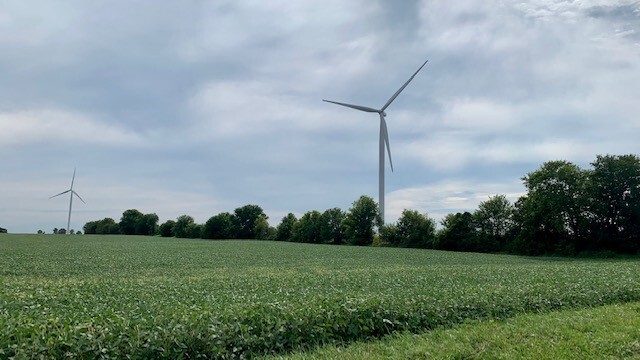A bill awaiting Governor JB Pritzker’s signature will set statewide standards for wind and solar farm siting.
Until now, counties have enjoyed wide latitude in setting the rules for where wind and solar energy arrays can locate. The new law would preempt local ordinances more restrictive than the new state standards.
Jen Walling is executive director of the Illinois Environmental Council. She said some county requirements were so restrictive that they were essentially bans on clean energy developments.
“A number of these counties weren’t representing their constituents and were taking away individual property rights,” she said.
Wind arrays in particular have created controversy, usually from landowners of properties neighboring those participating in the projects. The state law would create a setback requirement of 1.1 times the maximum blade tip height of the wind tower to the nearest point on the property line of nonparticipating properties, or 2.1 times for nonparticipating residences.
The law also requires occupied community buildings or nonparticipating residences not experience more than 30 hours of shadow flicker per year. Those are the moving shadows created by moving wind turbine blades at certain times of the day.
The Illinois Farm Bureau was opposed to House Bill 4412. Director of state legislation Kevin Semlow said the group finds the legislation lacking in some areas.
“Some of the setback distances within the legislation need to be adjusted to better reflect a much safer and adequate way that those facilities should be sited,” Semlow said.
The Farm Bureau also wants the Illinois Department of Agriculture and local counties to have more authority in the legislation to enforce agricultural impact mitigation agreements, and more language addressing drainage issues from the developments.
Walling said the legislation doesn’t take counties out of the process. She said the law still require public hearings, building and road use permits, and other ways for the public and local government officials to participate in wind and solar array siting.
“There are standards that are set in the bill that are used in a number of different counties that have successfully had wind projects that are supported by the county and supported by the neighbors. So, we put in some some of those things that have worked in a number of counties throughout the state,” she said, noting the standards do take various environmental and ecological factors into account.
State senator Dave Koehler (D-Peoria) was a co-sponsor of the legislation. He said it’s a good compromise measure.
“I think that this is a good attempt to kind of strike a balance between a state standard and local control,” he said.
Walling said environmental groups worked closely with Gov. Pritzker’s office on the bill, and she expects it to be signed into law.
“Ultimately, the climate crisis is hitting us and we need to see these,” said Walling. “I think there’s also a real challenge in downstate Illinois, with economic development, where we’re seeing jobs and factories closed, not related to anything that has to do with environmental protection. That has to do with the economy. And the more that we can bring property tax dollars into distressed communities, the better off we’re going to be as a state.”
Gov. Pritzker pledges to convert Illinois to 100% clean energy by 2050.

